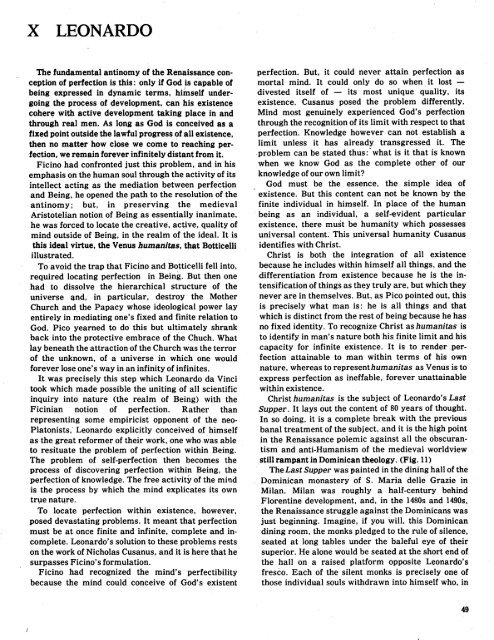Renaissance and
Renaissance and
Renaissance and
You also want an ePaper? Increase the reach of your titles
YUMPU automatically turns print PDFs into web optimized ePapers that Google loves.
X<br />
LEONARDO<br />
The fundamental antinomy of the <strong>Renaissance</strong> con- perfection. But, it could never attain perfection as<br />
ception of perfection is this: only if God is capable of mortal mind. It could only do so when it lost --<br />
o I<br />
being expressed in dynamic terms, himself under- divested itself of -- its most unique quality, its<br />
going the process of development, can his existence existence. Cusanus posed the problem differently.<br />
cohere with active development taking place in <strong>and</strong> Mind most genuinely experienced God's perfection<br />
through real men. As long as God is conceived as a through the recognition of its limit with respect to that<br />
fixed point outside the lawful progress of all existence, perfection. Knowledge however can not establish a<br />
then no matter how close we come to reaching per- limit unless it has already transgressed it. The<br />
fection, we remain forever infinitely distant from it. problem can be stated thus: what is it that is known<br />
F/c/no had confronted just this problem, <strong>and</strong> in his when we know God as the complete other of our<br />
emphasis on the human soul through the activity of its knowledge of our own limit<br />
intellect acting as the mediation between perfection God must be the essence, the simple idea of<br />
<strong>and</strong> Being, he opened the path to the resolution of the _existence. But this content can not be known by the<br />
antinomy; but, in preserving the medieval finite individual in himself. In place of the human<br />
Aristotelian notion of Being as essentially inanimate, being as an individual, a self-evident particular<br />
he was forced to locate the creative, active, quality of existence, there mu§t be humanity which possesses<br />
mind outside of Being, in the realm of the ideal. It is universal content. This universal humanity Cusanus<br />
this ideal virtue, the Venus humanims, that Botticelli identifies with Christ.<br />
illustrated. Christ is both the integration of all existence<br />
To avoid the trap that F/c/no <strong>and</strong> Botticelli fell into, because he includes within himself all things, <strong>and</strong> the<br />
required locating perfection in Being• But then one differentiation from existence because he is the inhad<br />
to dissolve the hierarchical structure of the tensif/cation of things as they truly are, but which they<br />
universe <strong>and</strong>, in particular, destroy the Mother never are in themselves. But, as P/co pointed out, this<br />
Church <strong>and</strong> the Papacy whose ideological power lay is precisely what man is: he is all things <strong>and</strong> that<br />
entirely in mediating one's fixed <strong>and</strong> finite relation to which is distinct from the rest of being because he has<br />
God. P/co yearned to do this but ultimately shrank no fixed identity. To recognize Christ as humanitas is<br />
back into the protective embrace of the Chuch. What to identify in man's nature both his finite limit <strong>and</strong> his<br />
lay beneath the attraction of the Church was the terror capacity for infinite existence. It is to render perof<br />
the unknown, of a universe in which one would fection attainable to man within terms of his own<br />
forever lose one's way in an infinity of infinites, nature, whereas to representhumanitas as Venus is to<br />
It was precisely this step which Leonardo da Vinci express perfection as ineffable, forever unattainable<br />
took which made possible the uniting of all scientific within existence.<br />
inquiry into nature (the realm of Being) with the Christ humanitas is the subject of Leonardo's Last<br />
Ficinian notion of perfection. Rather than Supper. It lays out the content of 80 years of thought.<br />
representing some empiricist opponent of the neo- In so doing, it is a complete break with the previous<br />
Platonists, Leonardo explicitly conceived of himself banal treatment of the subject, <strong>and</strong> it is the high point<br />
as the great reformer of their work, one who was able in the <strong>Renaissance</strong> polemic against all the obscuranto<br />
resituate the problem of perfection within Being. tism <strong>and</strong> anti-Humanism of the medieval worldview<br />
The problem of self-perfection then becomes the still rampantinDominicantheology. (Fig. 11)<br />
process of discovering perfection within Being, the The Last Supper was painted in the dining hall of the<br />
• . /<br />
perfection of knowledge. The free act_vlty of the mind Dominican monastery of S. Maria delle Grazie in<br />
is the process by which the mind explicates its own Milan. Milan was roughly a half-century behind<br />
true nature. Florentine development, <strong>and</strong>, in the 1480s <strong>and</strong> 1490s,<br />
To locate perfection within existence, however, the <strong>Renaissance</strong> struggle against the Dominicans was<br />
posed devastating problems. It meant that perfection just beginning. Imagine, if you will, this Dominican<br />
must be at once finite <strong>and</strong> infinite, complete <strong>and</strong> in- dining room, the monks pledged to the rule of silence,<br />
complete. Leonardo's solution to these problems rests seated at long tables under the baleful eye of their<br />
on the work of Nicholas Cusanus, <strong>and</strong> it is here that he superior. He alone would be seated at the short end of<br />
surp_assesFicino'sformulation, the hall on a raised platform opposite Leonardo's<br />
Ficino had recognized the mind's perfectibility fresco. Each of the silent monks is precisely one of<br />
because the mind could conceive of God's existent those individual souls withdrawn into himself who, in<br />
49

















